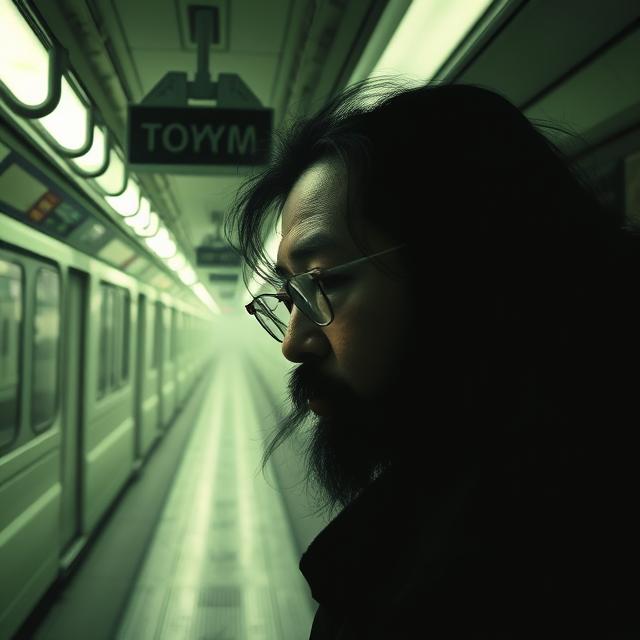The morning of March 20, 1995, began with the usual bustling energy of Tokyo’s commuters, unaware that they were about to become unwitting participants in a real-life nightmare. As trains glided through the city’s intricate subway system, a coordinated attack unleashed a silent, invisible terror: sarin gas. This act of domestic terrorism, orchestrated by the doomsday cult Aum Shinrikyo, not only shook Japan to its core but also exposed the terrifying potential of charismatic leaders, apocalyptic beliefs, and the deadly consequences of unchecked fanaticism. The events of that day, and the history of Aum Shinrikyo leading up to it, serve as a chilling reminder of the seductive and destructive power of cults, etching a dark chapter into the annals of both true crime and the study of aberrant psychology.
To understand the horror of the Tokyo subway attack, one must first trace the origins and the ascent of Aum Shinrikyo. The cult’s founder and enigmatic leader was Shoko Asahara (born Chizuo Matsumoto). Asahara, partially blind and with a messianic complex, began his spiritual journey in the 1980s, initially focusing on yoga and esoteric practices. He gradually amassed a following, drawn to his claims of spiritual enlightenment and his increasingly apocalyptic pronouncements.
The name “Aum Shinrikyo” itself is significant. “Aum” is a sacred sound in Hinduism and Buddhism, representing the universe’s vibration. “Shinrikyo” translates to “Supreme Truth Teaching.” This blend of Eastern religious concepts with Asahara’s own often bizarre interpretations formed the core of the cult’s ideology.
Asahara’s teachings evolved from relatively benign spiritual practices to a far more sinister doctrine centered on an impending global apocalypse, which he claimed only his followers would survive. He prophesied a Third World War and other catastrophic events, positioning Aum Shinrikyo as the ark that would shelter the chosen few. This apocalyptic worldview, coupled with Asahara’s growing megalomania, became a potent and dangerous cocktail.
The cult rapidly gained followers, attracting a diverse group that included highly educated individuals such as scientists, doctors, and engineers. This intellectual capital would later prove crucial in the development and execution of their nefarious plans. The promise of spiritual salvation, coupled with a sense of belonging and purpose, proved alluring to those disillusioned with mainstream society or seeking deeper meaning in their lives.
As Aum Shinrikyo’s influence grew, so did its activities. The cult established communes, known as “satellites,” where followers often lived in isolation, completely devoted to Asahara and his teachings. Allegations of coercive recruitment tactics, brainwashing, and the exploitation of followers began to surface. Those who tried to leave the cult often faced intense pressure and even violence.
The cult also began to engage in criminal activities, initially to fund its operations and later, it seems, as a manifestation of its increasingly paranoid and violent ideology. These activities included fraud, illegal possession of firearms, and even murder. Several disappearances of those critical of the cult or attempting to leave were linked to Aum Shinrikyo.
One of the early, chilling precursors to the subway attack occurred in June 1994 in Matsumoto, Nagano Prefecture. Aum Shinrikyo members released sarin gas into a residential area, killing eight people and injuring hundreds. This incident, though smaller in scale than the Tokyo attack, demonstrated the cult’s possession of and willingness to use chemical weapons. However, at the time, the perpetrators were not immediately identified as Aum Shinrikyo, and the incident was not widely understood as a terrorist act by a cult.
The stage was thus set for the horrific events of March 20, 1995. On that fateful Monday morning, at the height of the commuter rush, five Aum Shinrikyo members simultaneously released sarin gas on multiple lines of the Tokyo subway. They carried bags containing the liquid nerve agent, puncturing them with sharpened umbrella tips and leaving them to dissipate on the crowded trains.
The effects were immediate and devastating. Sarin, a highly potent nerve agent, disrupts the nervous system, leading to a cascade of physical symptoms including blurred vision, chest tightness, nausea, convulsions, and ultimately, respiratory failure and death. Panic erupted on the subway cars and stations as commuters collapsed, struggling to breathe, and the acrid fumes spread.
The attack resulted in 13 deaths and thousands of injuries, some of which were severe and long-lasting. The sheer randomness and the public nature of the attack sent shockwaves through Japanese society, shattering the long-held perception of Japan as a safe and orderly nation.
The aftermath of the sarin attack triggered a massive police investigation. Raids on Aum Shinrikyo facilities revealed a disturbing arsenal, including chemical weapons, biological agents, and conventional firearms. The scale of the cult’s operations and their capacity for violence were far greater than initially imagined.
Shoko Asahara was eventually arrested and, after a lengthy trial, sentenced to death. Many other high-ranking members of the cult were also arrested and convicted for their roles in the subway attack and other crimes.
The Tokyo subway attack brought the dangers posed by doomsday cults into sharp focus globally. It highlighted how charismatic leaders could manipulate followers into committing acts of extreme violence in the name of twisted ideologies. The case also raised critical questions about religious freedom, the limits of belief, and the responsibility of societies to identify and address the potential threats posed by such groups.
Aum Shinrikyo’s ideology was a bizarre syncretism, blending elements of Buddhism, Hinduism, Christianity, and Asahara’s own unique, often outlandish, interpretations. He claimed to have achieved enlightenment and possessed supernatural powers. His prophecies of doom and salvation resonated with certain individuals seeking meaning or escape.
The cult’s structure was hierarchical, with Asahara at the apex, wielding absolute authority. Followers often severed ties with their families and the outside world, dedicating themselves entirely to the cult’s doctrines and activities. This isolation and the intense indoctrination they underwent contributed to their willingness to carry out Asahara’s commands, no matter how extreme.
The acquisition of scientific expertise within the cult was particularly alarming. Highly educated members were tasked with developing the chemical and biological weapons, demonstrating the dangerous intersection of scientific knowledge and extremist ideology.
Even after the arrests and convictions of its leaders, the legacy of Aum Shinrikyo persists. The cult rebranded itself as Aleph and later Hikari no Wa (Circle of Rainbow Light), though many remain wary of these successor organizations. They continue to be monitored by authorities.
The Tokyo subway sarin attack remains a stark reminder of the potential for extreme violence when apocalyptic beliefs take hold and are acted upon by devoted followers of a charismatic but dangerous leader. It underscores the importance of critical thinking, the dangers of isolation and blind faith, and the need for vigilance against the insidious creep of extremist ideologies. The scars of that day run deep, not just in the physical and psychological wounds of the survivors, but also in the collective memory of a nation forced to confront the unimaginable. The cult of death’s grip, though seemingly broken, serves as a perennial warning from the sinister archive of human extremism.
Want to explore the shadows even deeper?
For more chilling cases like this, visit SinisterArchive.com—where the legends are real.




